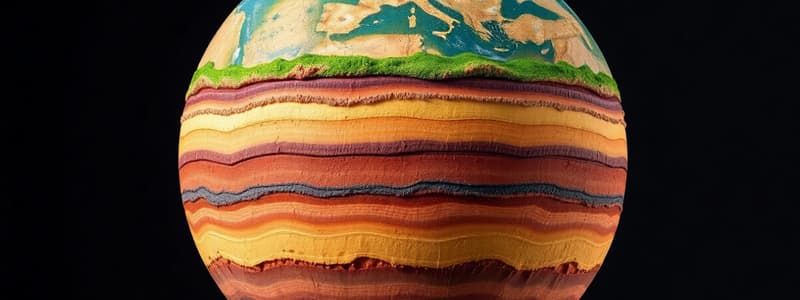Podcast
Questions and Answers
Which layer of the Earth is solid and composed mainly of metallic iron and nickel?
Which layer of the Earth is solid and composed mainly of metallic iron and nickel?
- Inner core (correct)
- Crust
- Mantle
- Outer core
The equator defines 90° latitude.
The equator defines 90° latitude.
False (B)
What are the two main types of crust on Earth?
What are the two main types of crust on Earth?
Oceanic crust and continental crust
Volcanoes are openings in the Earth's crust through which _____, ash, gases, and pyroclastic materials erupt.
Volcanoes are openings in the Earth's crust through which _____, ash, gases, and pyroclastic materials erupt.
Match the following elements with their corresponding properties or effects:
Match the following elements with their corresponding properties or effects:
Which factor primarily contributes to warm temperatures near the equator?
Which factor primarily contributes to warm temperatures near the equator?
Volcanic eruptions have no impact on atmospheric composition.
Volcanic eruptions have no impact on atmospheric composition.
Name the processes involved in the water cycle.
Name the processes involved in the water cycle.
Flashcards
What is the Earth's crust?
What is the Earth's crust?
The outermost solid layer of Earth, divided into oceanic and continental crust.
What is the Earth's mantle?
What is the Earth's mantle?
A thick layer of silicate rocks below the crust, further divided into the upper and lower mantle.
What is the Earth's outer core?
What is the Earth's outer core?
The liquid metallic iron and nickel layer that generates Earth's magnetic field.
What is the Earth's inner core?
What is the Earth's inner core?
Signup and view all the flashcards
What is the equator?
What is the equator?
Signup and view all the flashcards
What are volcanoes?
What are volcanoes?
Signup and view all the flashcards
Why is water essential for life on Earth?
Why is water essential for life on Earth?
Signup and view all the flashcards
What are some unique properties of water?
What are some unique properties of water?
Signup and view all the flashcards
Study Notes
Layers of the Earth
- The Earth's interior is layered, with distinct compositional and physical properties.
- These layers include the crust, mantle, outer core, and inner core.
- The crust is the outermost solid layer, divided into oceanic and continental crust.
- The mantle is a thick layer composed mainly of silicate rocks, and is further divided into the upper and lower mantle.
- The outer core is liquid metallic iron and nickel, and generates the Earth's magnetic field.
- The inner core is solid metallic iron and nickel, under immense pressure.
- Each layer plays a critical role in Earth's dynamics and processes.
The Equator
- The equator is an imaginary line that circles the Earth, equidistant from the North and South Poles.
- It defines the 0° latitude.
- It divides the Earth into the Northern and Southern Hemispheres.
- The equator experiences continuous daylight and darkness for equal periods.
- Locations near the equator exhibit warm temperatures due to more direct sunlight.
- The equator is important for studying global weather patterns and climate.
- It's a crucial point for measuring distances and locating positions on Earth.
Volcanoes
- Volcanoes are openings in the Earth's crust through which molten rock (magma), ash, gases, and pyroclastic materials erupt.
- Volcanic eruptions can be explosive or effusive, depending on the viscosity of the magma and the amount of dissolved gases.
- Volcanic activity occurs along plate boundaries, where tectonic plates interact.
- Magma originates from the Earth's mantle, rising to the surface through cracks and weaknesses in the crust.
- Volcanic eruptions can have significant impacts on the environment, including:
- changes to landscapes
- soil fertility
- atmospheric composition
- climate change
- Volcanic eruptions can release gases like sulfur dioxide, which contribute to acid rain.
Water
- Water is essential for life on Earth.
- Water's unique properties make it vital for various biological and geological processes.
- Its high specific heat capacity helps regulate Earth's temperature.
- It exists in three states: solid (ice), liquid (water), and gas (water vapor).
- Water's polarity allows it to dissolve many substances making it a universal solvent.
- Water cycles through various processes including evaporation, condensation, precipitation, and transpiration.
- The water cycle sustains life on Earth, replenishing sources of fresh water.
- The distribution of water across the Earth's surface varies geographically and temporally.
Studying That Suits You
Use AI to generate personalized quizzes and flashcards to suit your learning preferences.




